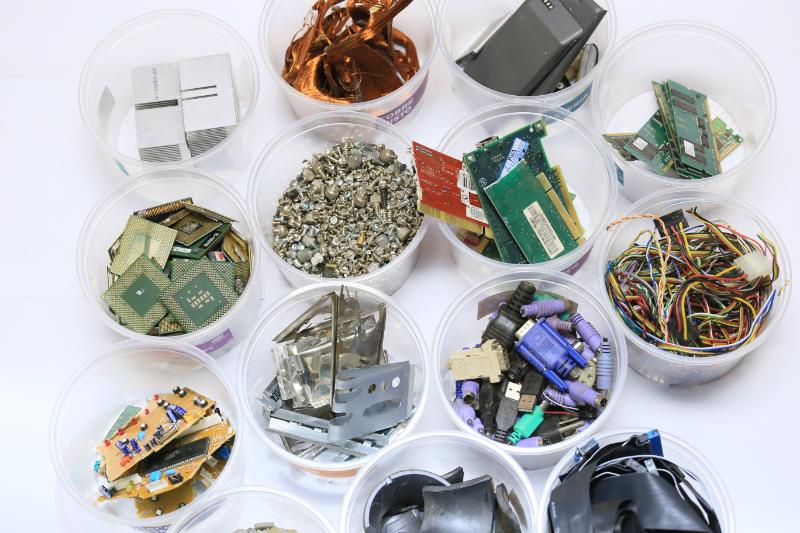7 Simple Techniques For Recycling Lives Services
Table of ContentsThe Of Recycling Lives ServicesIndicators on Recycling Lives Services You Need To KnowThe Main Principles Of Recycling Lives Services Excitement About Recycling Lives ServicesGet This Report on Recycling Lives Services7 Easy Facts About Recycling Lives Services Described

E-waste recycling is a lot more complex than standard waste recycling. Generally, the very first step of the recycling procedure is hands-on sorting. Once e-waste is collected and transported to the reusing facilities, workers arrange the e-waste into classifications according to their kinds and versions. All electronic gadgets will be checked out, and of which the components that are still practical will certainly be drawn out to be recycled; they can either be offered as private parts or be integrated to develop a new phone or computer system (recycling lives services).
Below, e-waste is thrown into a massive equipment and is shredded right into tiny items, yet before that, it should first experience a procedure called de-manufacturing, which refers to the action of disassembling a product right into components. https://www.metal-archives.com/users/rcyclng1vssvc. This procedure is to get rid of all the possibly hazardous materials in electronic gadgets that will ruin the equipment or pollute the environment when disposed into garbage dumps
Some Known Details About Recycling Lives Services

Next off, the waste is more divided with water. At this phase, nearly every little thing remaining are non-magnetic materials; they will go with another device full of water, where products with a reduced family member thickness, mostly plastic, will certainly stream, while various other products, like glass, will certainly sink. Lastly, before recycled products are marketed, is to examine if there are any kind of remaining beneficial materials adhered to the plastic.
A Biased View of Recycling Lives Services
Reusing e-waste not just protects against hazardous materials from entering our bodies and right into the setting, yet the procedure additionally lowers the harmful environmental impacts created by the extraction and mining of virgin materials. Besides, the potential financial advantages that can be acquired from this sector are substantial. The discarded e-waste in 2019 alone deserved even more than US$ 57 billion.
Computer systems and digital devices are made from several types of plastic, metal, glass and precious metals. Our goal when recycling electronic devices is to divide the different products from each other. The "item" we create from reusing is tidy separated streams of recycled plastic, iron, steel, copper, aluminum, glass and rare-earth elements.
2-1/2 min video clip shows electronic devices being recycled at a SLS facility. The customer reports we are able to create depends on how tools is taken care of prior to being recycled.
An Unbiased View of Recycling Lives Services
Our significant recycling sites are furnished with automated commercial shredders, conveyor systems and sorting devices. After threats are removed, the computer tools is fed by conveyor into a big shredder. The shredder rips the material into huge items, about 2" to 6" in diameter. This very first step prepares the e-waste to begin the procedure of dividing plastic components from steel, copper, light weight aluminum, glass and various other commodities.
After shredding, the conveyor belts push the e-waste through magnets, eddy currents, infrared video cameras and air jets. These modern technologies arrange out different material types and different arranged product from the e-waste stream.
5 Simple Techniques For Recycling Lives Services
Dividing Iron and Steel from e-Waste After shredding, conveyor belts transfer the shredded computers and e-waste under an effective magnet, which divides iron and steel from the shredded e-waste (recycling lives skips). The steel and iron are collected in pallet sized bags and gotten ready for sale as reused asset materials. Separating Light see Weight Aluminum, Copper and Circuit card from e-Waste After passing under the magnet, the e-waste remains to relocate using the conveyor belts with additional mechanical separators
An aesthetic examination and hand sorting improves the top quality of the drawn out products. The separated streams of light weight aluminum, copper, and circuit boards are gathered in pallet sized bags and planned for sale as reused product materials. Benefits of Recycling Recycling vs - https://www.gaiaonline.com/profiles/rcyclng1vssvc/46850349/. Virgin Material The apart assets are used to make future generation products
Using recycled product in the manufacturing of new items has benefits that go much beyond material reuse. It reduces contamination and carbon discharges, lowers power and water intake and maintains useful materials out of land fills. As each asset is separated from the e-waste stream, the material is accumulated in pallet sacks or big cardboard boxes and delivered to another processor or directly to a manufacturer.
The Ultimate Guide To Recycling Lives Services
It minimizes air pollution and carbon discharges, decreases energy and water consumption and keeps helpful products out of land fills. SLS has actually made a reputation of generating high quality recyclables out of our facilities. Suppliers and additional processors seek us out being used our recycled assets. SLS goes to the center of establishing ingenious e-waste recycling solutions.
Customers can get fewer things while reusing and reusing more. Federal governments can develop e-waste management systems to collect and recycle, drawing out in a safe method some of the approximated $62.5 billion of value from discarded materials. Finally, firms can build products designed to last, not to be changed, and to be reused.